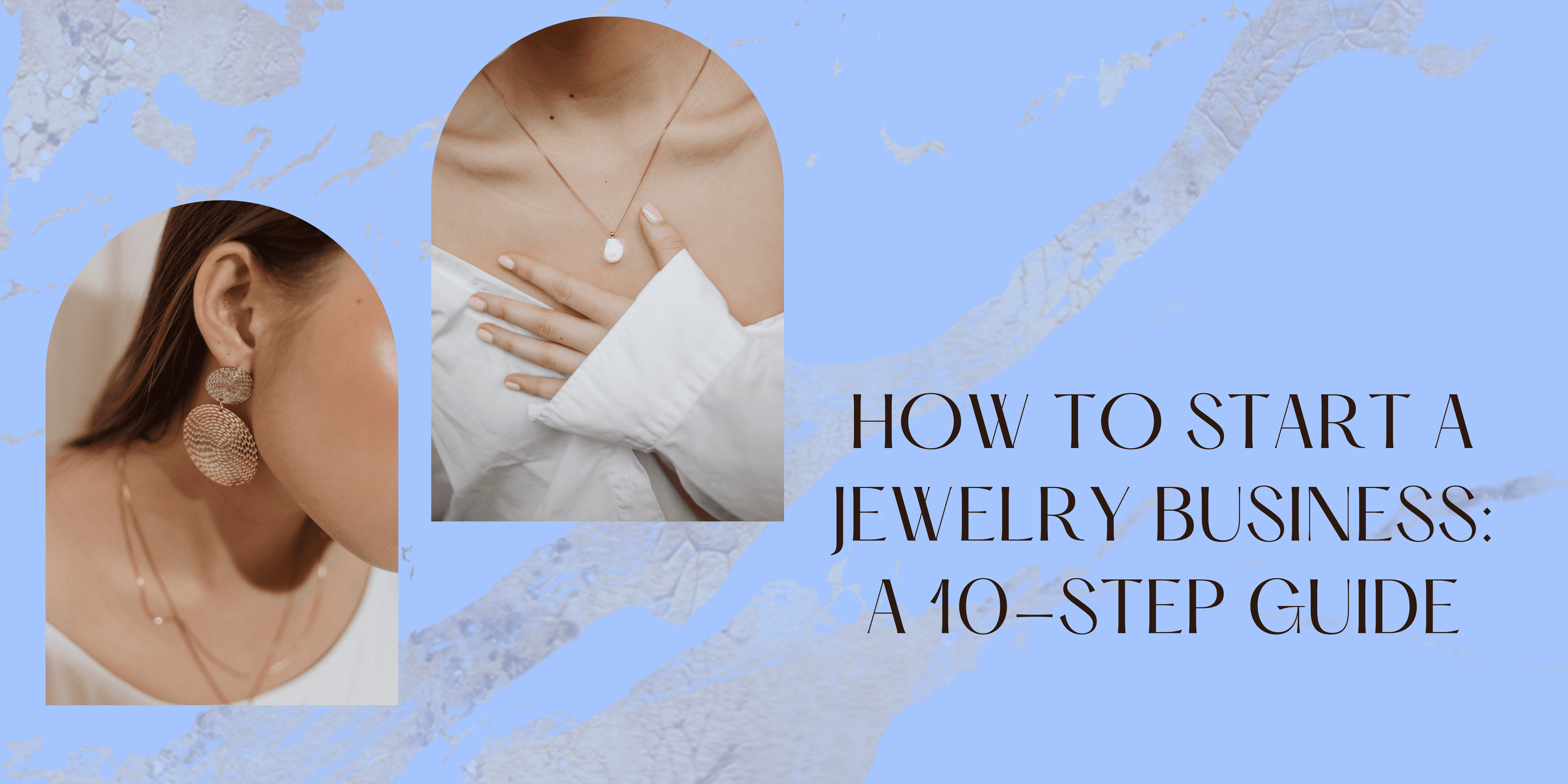
Whether you're a passionate craftsman or an entrepreneur with a nose for money, launching a jewelry business is both challenging and rewarding. This guide will walk you through the essential steps to transform your vision into a thriving jewelry business.
1. Find Your Niche in the Jewelry Industry
The jewelry industry is diverse, competitive and crowded, but has enough room for everyone. When thinking about starting a jewelry business it is crucial to decide on your niche. This means identifying a specific area within the jewelry market where your brand can thrive.
You can define your niche by deciding what type of jewelry you will sell. This will help keep you focused and allow you to market your jewelry in the most effective way.
There are three types of jewelry in the industry:
Fine Jewelry: in this category we find high-end jewelry that features precious materials such as gold, diamonds and rare stones. It typically caters to a clientele looking for luxury and exclusivity. The pieces exhibit true craftsmanship and are paired with high-end customer service.
Fashion or Costume Jewelry: made from non-precious metals and synthetic stones, fashion jewelry is more on the affordable side. Usually offering trendy pieces, it appeals to a broader and more price-sensitive audience.
Artist-Designed Jewelry: this category encompasses the more unique and artistic jewelry pieces. Appealing to a niche market, this type of jewelry is hand-made, one of a kind, and follows the jeweler’s artistic vision. The target customer is usually looking for something special and unique.
Independent jewelry stores can boost revenue by offering repair and appraisal services, even for items not originally sold in their shop, allowing them to attract a wider customer base.
With the rise of big franchises, independent stores can stand out by providing personalized service and high-quality repairs, fostering customer loyalty.
By embracing these services, independent jewelers can turn competition into profitable opportunities.
When it comes to sourcing inventory, jewelry businesses can either make their pieces or resell items from various brands and vendors. It is also possible to adopt a versatile approach where a store both makes its jewelry and buys branded jewelry.
Custom jewelry tends to bring in higher margins and fosters a loyal customer base, as each piece is tailored to the individual's narrative. However, this custom approach can be costly, requiring skilled jewelers and effective store management.
Tools like CaratIQ simplify the process by tracking custom orders, assigning tasks to employees, and automatically notifying customers when their pieces are ready for pickup, reducing the frequency of status inquiries.
On the other hand, vendor-sourced jewelry allows for higher volume sales but at lower margins, presenting its own set of challenges.
Ultimately, offering both options and gradually focusing on the approach that aligns best with your store's style is the most effective strategy for sustainable growth.
2. Study the Competition and Market Trends
Understanding your competitors and staying ahead of market trends is essential when starting a jewelry business. It is important to identify both your direct and indirect competitors to be able to gauge market temperature and stay relevant in the industry.
This can be done using multiple tools:
Research Market Trends: it is essential to keep up with jewelry market trends by attending trade shows, following industry-related news, and analyzing trend reports. Social media is also a great market trend indicator that can be very insightful when starting a jewelry business.
Follow Jewelry Trends: as mentioned, social media platforms such as Instagram or Pinterest are excellent resources for tracking current jewelry trends. Influencers and fashion bloggers are also worth following as they will wear the trend the customer will be looking for.
Find Design Inspiration: you want your jewelry to be trendy and appealing, but also unique. For your pieces to stand out, look for inspiration in your day-to-day environment: cultural trends, nature, art, are all great sources of inspiration for design. Engaging with customer preferences through social media polls and reviews can also spark new design ideas. Don’t be afraid to ask for opinions and feedback!
3. Choose a Creative Name (with an Available Domain)
Choosing a name is key to starting a successful jewelry business. You want your brand name to be catchy, memorable and unique, to reflect the essence of your niche, and to resonate with your target audience.
Make sure your company name reflects the vibe you want to give, as this is the first thing the customer will see and it will set the tone of your brand.
Once you’ve settled on a name, you need to ensure your domain name and social media handles are available. It is essential to have your company name match on all platforms to maintain brand consistency and avoid confusion.
Online tools such as Namecheap or GoDaddy can help you check domain name availability.
4. Define Your Brand and Story
Once you have decided on a name, the next step is crafting a compelling brand story and voice, that resonates with your target customer.
Your brand story should be unique and personal: it should include how and why you started a jewelry business, where your inspiration comes from, what your brand’s values are. You want the customer to understand the story behind your jewelry pieces and identify with the brand.
Using storytelling is key here, to highlight what makes your brand unique.
5. Write a Jewelry Business Plan
A well-crafted business plan is essential to start your jewelry business. It will serve as a roadmap for your business strategy and will also be crucial in securing investment.
An effective business plan should include the following key sections.
Executive Summary: this is a concise overview of your entire business plan. It highlights your business’s vision and key objectives. It’s the first thing potential partners will read, so it needs to be engaging and clear and should encapsulate the essence of your business.
Market Analysis: this takes a look at the industry, the market trends, and the competition. It identifies market needs, potential challenges, gaps and opportunities, allowing you to set up your business effectively.
Target Audience: this helps you define your ideal customers and their demographics, so you can identify their needs and how to address them in terms of marketing and product offer.
Sales Strategy: this outlines how you plan to sell your jewelry. It covers pricing, sales channels, and marketing tactics. This strategy will ensure you bring in revenue and are able to grow in sales.
Operations Plan: the day-to-day operations of your jewelry business. In it you will find the strategy for production, supply chain management, facilities, and staffing.
Financial Projections: lastly, this section provides detailed financial forecasts, using elements such as income statements, cash flow statements, and balance sheets. This is how you will define your revenue model and identify your funding requirements
6. Produce or Source Your Jewelry Products
One of the key elements you will need to decide on when starting a jewelry business is whether to produce your jewelry in-house or source it from external suppliers. Multiple methods already exist for producing or sourcing jewelry, and it is vital that you research them to make an informed decision. Each method has its pros and cons:
Handcrafted Jewelry Production: this method is ideal for unique, artisanal pieces that aim to attract customers who are looking for one-of-a-kind pieces. However, the uniqueness of the jewelry pieces has a down-side: handcrafting jewelry requires more time and necessitates a specific skill-set.
Factory Outsourced Production: if you’re looking for mass production and scaling, this method will probably be the most suitable for you. Its main challenge however will be to find reliable manufacturers that will deliver products of quality, in a timely manner and at a low enough cost to respect your margins. Ensuring proper inventory management will also be a challenge when doing outsourced mass production.
Print-on-Demand Jewelry Production: this method allows for the jeweler to offer custom designs to his customers. The main advantage of print-on-demand is that you will not have to deal with an inventory, which can be time-consuming and complicated. However, print-on-demand usually has a higher cost per unit, which means your pieces might sell for higher than your competitors. Ensuring you are selling at the right market price and can guarantee great quality are essential when selling custom designs.
Dropshipping and Resale Curation: another way to sell your pieces without holding inventory is to use dropshipping and resale curation. But keep in mind that this method requires careful partner selection, as they will be selling and representing your brand. You also have to ensure quality control over your partners, as they will be the ones customer-facing.
CaratIQ offers a centralized platform to manage supplier information, pricing, and order histories. This user-friendly system allows for real-time inventory updates, which enhances visibility and helps stores avoid overstocking or stockouts while enabling better planning. By automating these processes, CaratIQ frees up valuable time, allowing jewelers to focus on customer service and sales strategies, ultimately boosting operational efficiency and profitability.
7. Set Up Your Jewelry Business Studio or Workspace
Whether you’re creating handcrafted pieces or managing a reselling business, a functional workspace is key.
Begin by selecting a dedicated space, large or small depending on your needs. Invest in essential equipment and tools, and organize your space efficiently: this might mean investing in soldering tools, pliers, wire cutters, a variety of beads, or shelving for inventory, a computer and internet connection, and packaging materials.
Utilize vertical storage solutions, like wall-mounted shelves or pegboards, to maximize space and keep things easily accessible. Implement a labeling system for inventory to streamline your workflow, and establish designated zones for different tasks, such as crafting, packaging, and shipping. By prioritizing organization and functionality, you can enhance productivity and creativity in your workspace.
In order to sell, your pieces must be attractive to the customer. Using a professional photographer to market your pieces is a great idea, and, even if it comes at a price, it is an investment worth exploring. A photographer will be able to capture the beauty of your pieces using proper lighting and backgrounds, ensuring high-quality images of your jewelry that fit your brand.
8. Build Your Ecommerce Store
In today’s world, an online store is crucial for selling jewelry. Many options exist: using an ecommerce platform like Shopify or BigCommerce, setting up your own website, selling via social media.
Your target audience, size and company goals will be factors in choosing the right platform. Make sure to do your research to select the best approach for your business.
Once selected, ensure you set up your online business properly, focusing on the essential pages such as the homepage, the brand story, the product listings, the contact pages and the customer reviews. Your goal is to attract customers to your platform and convert traffic into sales, so make sure you put in the work on those essential pages.
CaratIQ offers free jewelry ecommerce websites and integrates with platforms such as Shopify and Wordpress.
9. Market Your Jewelry Brand and Scale
When you start a jewelry business, one of the keys to success is to be known to your customers. Various effective marketing strategies exist to promote your jewelry business.
Social Media Marketing: use platforms like Instagram, Pinterest, and TikTok to showcase your designs and engage with your audience. Make sure you stay relevant to your audience by following trends and by having a good social media presence.
Collaborations and Influencer Marketing: partner with influencers who can help promote your brand to a broader audience. Influencer selection is key, as you want them to reflect your brand and your values, and you want to select a partner whose following corresponds to your target audience.
Public Relations for Jewelry Brands: increase brand visibility by building media relationships and seeking features in relevant publications. Make sure to be realistic in your goals (start by reaching out to a local newspaper for example, not aiming for a Vogue highlight article right away) and build on as you go. Ensure you reach out to outlets that will promote your pieces while accurately portraying your brand.
CaratIQ’s automated marketing features help jewelry businesses engage customers effectively while saving time. With personalized email campaigns, automated reminders for special occasions, and targeted promotions, jewelers can maintain meaningful connections with their clientele. The platform also allows for customer segmentation and tracks engagement metrics to refine future strategies. By streamlining these marketing efforts, CaratIQ enhances marketing effectiveness, increases customer loyalty and ups revenue for independent jewelers.
10. Scale Your Business
When starting your jewelry business, you will start on a small scale. As your business grows, more opportunities will come to you and new doors will open.
As you gain market shares, make sure you consider expanding your product lines, increasing production capacity, and exploring new markets. But don’t overexpand yourself, scaling is a step-by-step process, and growing your business too quickly could lead to failure.
For long-term business success, make sure to focus on optimizing operations and building a loyal customer base through excellent customer service and engagement. You also want to stay true to your brand voice and values throughout the process to ensure customer fidelity.
As your jewelry store scales up, CaratIQ provides essential support to ensure seamless operations across all sites. The platform offers cloud-based centralized inventory management, allowing store owners to track stock levels and sales data in real time, even while having multiple store locations.
Its reporting tools help identify trends and performance metrics, enabling informed decision-making.
With its scalable solutions, CaratIQ jewelry management software empowers jewelers to grow confidently while enhancing efficiency and customer satisfaction at every level.
Read Also:
How Much Does it Cost to Start a Jewelry Business

You may also like
View all

